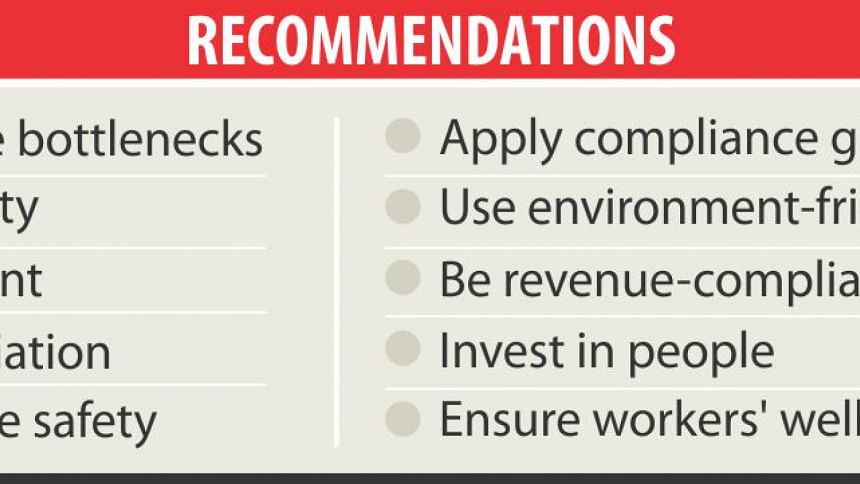Goal ambitious but achievable

Bangladesh's target to double its apparel exports by next five years is daunting but achievable if the country can fix infrastructure bottlenecks, boost productivity and attract investment.
“The target is very simple, but a challenging one,” said Sharif As-Saber, a Bangladeshi professor at RMIT University, an Australia-based public university.
He said the apparel exports were currently growing at nine percent. But the growth should be at least 11 percent to reach the target of $50 billion by 2021 -- a goal Bangladesh Garment Manufacturers and Exporters Association (BGMEA) set in 2014.
Garment sector accounts for 81 percent of the country's overall export earnings, and employs more than four million people, mostly poor women from rural Bangladesh.
Garment exports grew 4.08 percent to $25.5 billion in fiscal 2014-15, according to data from state-run Export Promotion Bureau.

Bangladesh would have to export an additional $5 billion per year for the next few years to reach the target.
Despite being the second largest producer of garment items in the world, Bangladesh accounts for only 5.09 percent of the global clothing market, according to Siddiqur Rahman, president of the BGMEA.
US Ambassador to Bangladesh Marcia Bernicat said setting a goal of doubling apparel exports in less than six years was ambitious. “But I don't know how you get big results without setting big goals.”
The diplomat expressed her country's commitment to helping Bangladesh reach the target.
She said Bangladesh's apparel sector is a major industry leader and is growing to be the top producer.
“It is not because of cheap labour. Buyers have told me there are countries that have lower wages than Bangladesh. What these industries [in other countries] don't have is skilled workforce that delivers time and again quality product on time.
“That's what puts this industry on top,” Bernicat observed.
They made the remarks at a roundtable styled "Target $50 billion: We Need Your Support to Reach It" at The Daily Star Centre in Dhaka. The BGMEA and The Daily Star jointly organised the discussion.
The sector has an opportunity to transform itself by adopting the international standards that are increasingly required of this industry and other industries everywhere, Bernicat said.
Talking about the duty and quota-free trade facility extended by the US to its trading partners, the American diplomat said all manufacturing units in every country had to adopt the same international standards to qualify for the trade preference, like the standards Bangladeshi manufacturers were asked to comply.
Ahsan H Mansur, executive director of Policy Research Institute, said the $50b target was very logical, as historically trade grew about the double of a country's gross domestic product (GDP) growth.
“If Bangladesh wants to grow its GDP by 7-8 percent the apparel exports will have to double the growth.”
He said the economy size doubled from $100 billion to $200 billion in the last five years. “If we can double our national income in five years, why can't we do the same in case of garment exports in the same time?”
But the task is not easy either, reminded the former economist of the International Monetary Fund.
In the next few years, Mansur said, Bangladesh would have to make the investment it has made over the last 35-40 years, which is a formidable task.
“This time, the investment has to be capital-intensive to achieve the same output.”
He said Bangladesh would have to invest $100-125 billion in the sector at the country's current capital output ratio of 4.5.
“The BGMEA has to think whether it would be able to make this amount of investment without foreign direct investment,” he said, adding that he did not think that Bangladesh would be able to raise the money from domestic sources.
More importantly, the standards that are being applied in Bangladesh should be applied globally. “If it is ensured, the cost of production in Vietnam, Cambodia and Myanmar will also go up. As a result, we will be able to remain competitive.”
Md Nojibur Rahman, chairman of the National Board of Revenue (NBR), said thanks to pragmatic and facilitative process of the government, Bangladesh's garment sector was touted as an alternative destination for companies leaving China.
He also said the government wanted to see the RMG industry as a well-governed sector. “If you do that and put in place energy-efficient and environment-friendly technologies, then there would be many more incentives coming from the NBR during the upcoming budget discussions and consultations.”
Daniel Seidl, a representative of the Brussels-based Foreign Trade Association in Dhaka, said more than 70 percent of Bangladesh's exports reach Europe and the US markets.
“But we can see that China and India are coming to Bangladesh to buy products for their local markets.
“That clearly puts pressure on our factories,” he pointed out.
Pierre Mayaudon, head of the European Union mission in Bangladesh, said that to reach the $50-billion target, Bangladesh would have to fight and win three battles: the battle of technology, international engagement and team spirit.
The battle of technology starts with remediation, and a fund of $200 million has been put on the table for the companies that need the money to implement the remediation plans, he said.
“But things are not moving very fast. So we need to put a mechanism in place so factories that need the fund can take the advantage from the donors,” he said.
Skilled workers, energy efficient machines and modern machineries are also needed, said the EU ambassador.
He also said Bangladesh also needed to invite a lot of foreign direct investment. It will give more chance to local industries to forge partnership with foreign investors. “Please, be more foreign investors-friendly.”
Mayaudon said the recent lifting of western sanctions on Iran opened up opportunity for Bangladesh to export garment products to the country, which have a per capita income of $5,000 and a population of 82 million.
Zahid Hussain, lead economist of the World Bank Bangladesh, said if Bangladesh could increase its export growth by 2-3 percentage points, then it would be able to reach the target.
As per 2015 McKinsey & Company report of 2015, 48 percent chief purchasing managers said they still saw Bangladesh as a sourcing destination, he said.
He said Bangladesh would have to increase productivity, but the lack of industrial land and energy stood as major barriers. And special economic zones have to be set up to ease crisis of industrial land, he said.
He backed BGMEA President Siddiqur Rahman's view on energy, saying many new factories could not start production as they had no gas connections. “If they can't go into production, new entrepreneurs would not be encouraged to make investment.”
Siddiqur said although the textile and garment sectors together consume five percent of the total gas production, they contribute hugely in job creation, earning foreign currency and the GDP.
KG Moazzem, additional research director of the Centre for Policy Dialogue, said if the BGMEA could provide a numerical statistics on how much additional power, gas, land and the number of skilled workers and mid-level managers they would need to reach the target, it would help the government to make decisions.
Srinivas Reddy, director of the International Labour Organisation in Dhaka, said respect for labour rights, fixing the safety issues and completion of the remediation process and investing in people were three major areas for the sustainable growth of the sector.
The $50billion will not only bring benefits for the 5,000 employers, but also to the 4-6 million workers if the workers are made partners-in-progress, he said.
Jochen Weikert, a programme coordinator of GIZ Bangladesh, said the garment sector association, the government, and the civil society collectively were no longer a small player in the global garment sector.
“If you raise your voice on the grounds of your enhanced responsibility and sustainability then your claim will be much more heard and credible,” he said while talking about bargaining over pricing issue.
Nazma Akter, a labour activist, said the living conditions of the workers and their wage had to be improved. Besides, trade union rights and freedom of association have to be ensured.
“Without ensuring the well-being of the workers, the sector will not be sustainable,” she said.
Moderating the event, Mahfuz Anam, editor and publisher of The Daily Star, said the garment sector was the growth engine for Bangladesh and had done wonders in the last two-three decades.
"They are now poised, in terms of infrastructure, ability and skills, for vigorous height."

 For all latest news, follow The Daily Star's Google News channel.
For all latest news, follow The Daily Star's Google News channel. 








Comments